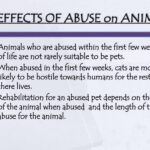Animal cruelty—a term that incites visceral reactions and demands societal attention—navigates a complex labyrinth of legal definitions and societal implications. The classification of these acts, whether as misdemeanors or felonies, is not merely a legalistic distinction; it encapsulates societal values, the evolving relationship between humans and animals, and the moral judgments we impose on certain behaviors. This article seeks to unpack the nuances of animal cruelty charges, illuminating the intricacies involved in categorizing these often-horrific acts.
At the outset, it is imperative to delineate the categorizations of animal cruelty as they stand in legal frameworks across various jurisdictions. Generally, animal cruelty can be bifurcated into two primary classifications: misdemeanors and felonies. The determinative elements often hinge on the severity of the act, the perpetrator’s intent, and the resultant harm inflicted upon the animal. Misdemeanor offenses typically encompass acts of neglect or harm that do not result in substantial injury or death. For instance, failure to provide adequate food, water, or shelter may fall into this category, subjecting the offender to lesser penalties such as fines or community service. The legal ramifications often vary by state, with some jurisdictions maintaining stringent laws, while others exhibit laxity.
Conversely, felonious acts of animal cruelty emerge from egregious behaviors that lack any semblance of compassion. Abusive acts that lead to serious injury or death of an animal, such as deliberate beating, torturing, or engaging in dog fighting, may escalate the charges to felony level. Such legal categorization sends a potent message: society unequivocally refutes violence against defenseless beings. While penalties vary, felony convictions often manifest in harsher repercussions, including imprisonment, significant fines, and an enduring criminal record.
But what drives the societal fascination with the legal ramifications of animal cruelty? Beyond the pragmatic concerns of punishment, lies a profound ethical contemplation of our responsibilities towards sentient beings. The increasing awareness and activism surrounding animal rights elucidate an evolution in public perception. The collective outrage over egregious instances of animal cruelty speaks not only to the acts themselves but also to our cultural zeitgeist. As we become more cognizant of animal sentience and welfare, our legal systems grapple with redefining justice in realms previously overlooked.
The growing prominence of animal rights activists and organizations has been instrumental in advocating for changes to recognize animal cruelty as a felony. These activists argue that our moral obligation is to protect those who cannot advocate for themselves. The correlation between societal values and legal definitions is particularly salient; as public sensitivity surrounding animal welfare burgeons, so too does the urgency to impose more stringent legal consequences for perpetrators of cruelty.
In recent years, there has been a notable shift in how animal cruelty laws are applied. Many states have revisited their legal frameworks, seeking to galvanize the penalties for these offenses. This transition often emerges in response to high-profile cases that evoke national outrage. For example, cases such as the horrific treatment of pit bulls in dog fighting rings have served to galvanize public sentiment, prompting legislators to take action to ensure that the justice system reflects the seriousness of these heinous acts. The outcomes of these cases are pivotal, not only in determining the fate of the offender but also in shaping societal discourse surrounding animal rights.
Nevertheless, challenges persist. The legal landscape surrounding animal cruelty is rife with complications, primarily influenced by geographical disparities and cultural attitudes towards animals. In some regions, certain forms of animal exploitation, such as factory farming, may be legally sanctioned, further complicating the dialogue surrounding cruelty. The tension between agricultural practices and animal welfare raises critical questions about how societal norms shape our understanding of cruelty. Is it hypocritical to denounce mistreatment of companion animals while turning a blind eye to the systematic exploitation of livestock? Undoubtedly, these contradictions invite deeper inquiry.
It is also essential to address the psychological dimensions associated with animal cruelty. Research has illuminated a disturbing correlation between individuals who perpetrate violence against animals and those who later engage in interpersonal violence. This psychological insight aligns with the belief that cruelty begets cruelty, thus stressing the importance of preventative measures and educational initiatives aimed at fostering empathy. Addressing the root causes—whether they be socio-economic, psychological, or cultural—can serve as a meaningful approach to mitigate not only animal cruelty but also broader societal violence.
Through the lens of legislation, society has an opportunity to reflect on its moral compass concerning animal welfare. The differentiation between misdemeanors and felonies allows for a nuanced approach to justice, yet it also remains a battleground for advocacy, ethics, and accountability. As we endeavor to understand the complexities of animal cruelty law, we must collectively strive to foster a society where compassion prevails over indifference, where the voices of the voiceless resonate within the hallowed halls of justice.
In summation, the classification of animal cruelty underscores a fundamental debate about ethics, legality, and societal responsibility. Whether viewed through the prism of criminal justice or cultural evaluation, it beckons a deeper exploration of our obligations toward non-human beings. The endeavor to combat animal cruelty is not merely the province of the legal framework; it necessitates a cultural shift towards empathy, responsibility, and unwavering advocacy for those who cannot defend themselves. The conversation surrounding the evolution of these laws is ongoing, yet the goal remains steadfast: an unwavering commitment to end the suffering of innocent lives.








